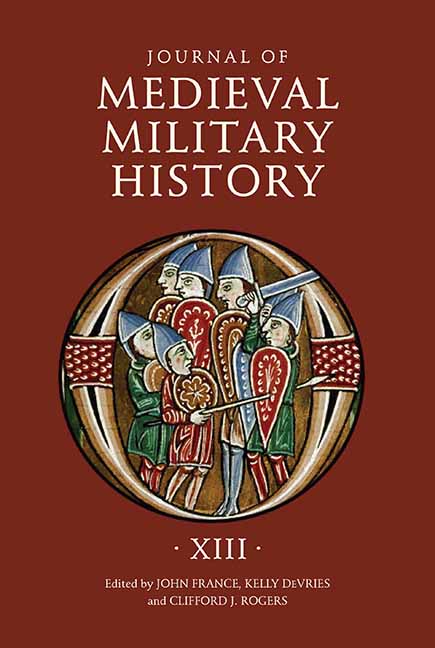Book contents
- Frontmatter
- Contents
- List of Illustrations and Table
- 1 Feudalism, Romanticism, and Source Criticism: Writing the Military History of Salian Germany
- 2 When the Lamb Attacked the Lion: A Danish Attack on England in 1138?
- 3 Development of Prefabricated Artillery during the Crusades
- 4 Some Notes on Ayyūbid and Mamluk Military Terms
- 5 Helgastaðir, 1220: A Battle of No Significance?
- 6 Por La Guarda De La Mar: Castile and the Struggle for the Sea in the Thirteenth and Fourteenth Centuries
- 7 The Battle of Hyddgen, 1401: Owain Glyndŵr’s Victory Reconsidered
- 8 The Provision of Artillery for the 1428 Expedition to France
- 9 1471: The Year of Three Battles and English Gunpowder Artillery
- 10 “Cardinal Sins” and “Cardinal Virtues” of “El Tercer Rey,” Pedro González de Mendoza: The Many Faces of a Warrior Churchman in Late Medieval Europe
- 11 Late Medieval Divergences: Comparative Perspectives on Early Gunpowder Warfare in Europe and China
- List of Contributors
- Journal of Medieval Military History 1477–545X
- De Re Militari and the Journal of Medieval Military History
10 - “Cardinal Sins” and “Cardinal Virtues” of “El Tercer Rey,” Pedro González de Mendoza: The Many Faces of a Warrior Churchman in Late Medieval Europe
Published online by Cambridge University Press: 25 May 2021
- Frontmatter
- Contents
- List of Illustrations and Table
- 1 Feudalism, Romanticism, and Source Criticism: Writing the Military History of Salian Germany
- 2 When the Lamb Attacked the Lion: A Danish Attack on England in 1138?
- 3 Development of Prefabricated Artillery during the Crusades
- 4 Some Notes on Ayyūbid and Mamluk Military Terms
- 5 Helgastaðir, 1220: A Battle of No Significance?
- 6 Por La Guarda De La Mar: Castile and the Struggle for the Sea in the Thirteenth and Fourteenth Centuries
- 7 The Battle of Hyddgen, 1401: Owain Glyndŵr’s Victory Reconsidered
- 8 The Provision of Artillery for the 1428 Expedition to France
- 9 1471: The Year of Three Battles and English Gunpowder Artillery
- 10 “Cardinal Sins” and “Cardinal Virtues” of “El Tercer Rey,” Pedro González de Mendoza: The Many Faces of a Warrior Churchman in Late Medieval Europe
- 11 Late Medieval Divergences: Comparative Perspectives on Early Gunpowder Warfare in Europe and China
- List of Contributors
- Journal of Medieval Military History 1477–545X
- De Re Militari and the Journal of Medieval Military History
Summary
A king was here, his name was Corsablis…
Archbishop Turpin has listened to his speech,
And hates him worse than any man that breathes.
His golden spurs he strikes into his steed,
And rides against him right valiant for the deed.
He breaks the buckler, he's split the hauberk's steel,
Into his breast driven the lance-head deep,
He spits him through…. [stanza 95]
Archbishop Turpin goes riding through the field;
Ne’er was mass sung by any tonsured priest
That of his body could do such valiant deeds!
He hails the Paynim: “God send the worst to thee!
Thou hast slain one for whom my whole heart grieves.”
Into a gallop he urges his good steed,
He strikes him hard on his Toledo shield,
And lays him dead upon the grassy green. [stanza 121]
Introduction
The two stanzas reproduced above come from one of the most famous works of medieval literature, the Song of Roland, first of the chansons de geste or “song of deeds,” depicting in a highly fictionalized manner what would ironically become Charlemagne's most remembered battle, the defeat of his rearguard at Roncevaux. Prominent among those named in the chanson as having died fighting at Roland's side was Archbishop Turpin of Rheims, to whom the passages refer. Although the appearance of the poem around 1100 converted Turpin into the prototype “warrior churchman” of the age, there is no certainty that such an individual actually existed outside of legend. To the extent that the fictional character accords with reality, he was probably a conflation of several clerics who held the see in the late eighth century, the best-known of whom was no warrior at all.
In contrast to such a shadowy figure, one encounters throughout the medieval period real flesh-and-blood warrior churchmen about whom a good deal can be known, men who make it possible to arrive at a better understanding of just what it meant to combine the two roles. One such individual who lived in the late Middle Ages was the cardinal-archbishop of Toledo, Pedro González de Mendoza (1428–95), who occupied the primate see in the Castilian church near the end of the fifteenth century and was dubbed by one of his early biographers el gran cardinal.
- Type
- Chapter
- Information
- Journal of Medieval Military HistoryVolume XIII, pp. 213 - 246Publisher: Boydell & BrewerPrint publication year: 2015



